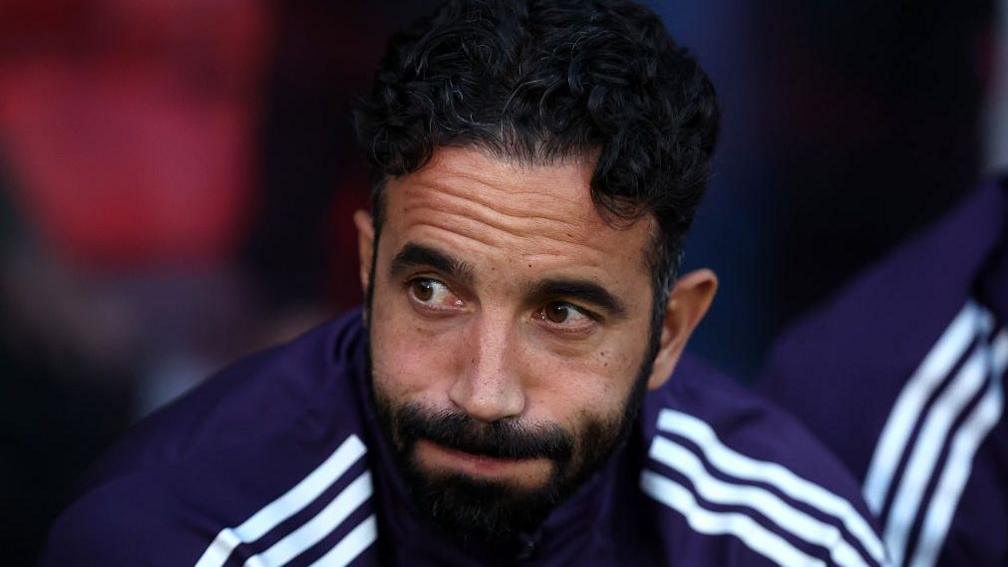Amorim’s Tactics Under Scrutiny: How Manchester United’s System Crumbles Under Pressure
Manchester United’s humiliating Carabao Cup defeat to League Two side Grimsby Town has intensified scrutiny of manager Ruben Amorim’s tactical blueprint. Despite a £200 million summer overhaul aimed at reviving the club’s fortunes, the Portuguese coach’s rigid system continues to misfire. While United aim to recover from last season’s dismal 15th-place finish, recurring patterns of failure reveal fundamental flaws in Amorim’s philosophy. This deep dive unpacks why his approach – theoretically sound but painfully predictable – is being ruthlessly exposed in the Premier League.
The Core of Amorim’s Tactics: A 5-2-3 Built for Control
At the heart of Amorim’s strategy lies a positional 5-2-3 formation prioritizing structure over spontaneity. Wing-backs hug the touchlines, central midfielders anchor narrow zones, and attackers operate within fixed corridors. The system’s primary weapon? Overloads. By clustering players on the flanks – typically the wing-back, nearby center-back, and a drifting attacking midfielder – United attempt to outnumber opponents and progress the ball into advanced areas.
This approach thrived at Sporting Lisbon, where superior technical quality masked its rigidity. But in England, where tactical adaptability is non-negotiable, Amorim’s tactics have backfired spectacularly. Opponents quickly identified the system’s robotic patterns, transforming United from contenders to punchlines.
Grimsby’s Masterclass: How Lower-League Opponents Cracked the Code
Grimsby’s shock victory wasn’t luck—it was a tactical autopsy. Their man-oriented high press dismantled Amorim’s setup by assigning each United player a personal shadow. This nullified the flank overloads, forcing the Red Devils into isolated 1v1 battles—a nightmare for a squad trained to prioritize quick passes over dribbling.
Two critical weaknesses emerged:
1. Dribbling Deficiency: Only Kobbie Mainoo’s mazy run for United’s lone goal offered resistance—a rarity in a system discouraging individual flair.
2. Static Positioning: Players remained glued to their zones, allowing Grimsby defenders to anticipate every pass.
Without the freedom to rotate or improvise, United’s attack became as predictable as a metronome.
Amorim’s Tactical Trap: The Up-Back-Through Routine Gone Stale
United’s primary attacking sequence—the up-back-through—epitomizes their predictability:
1. A direct ball from defense to Bruno Fernandes
2. A one-touch layoff to a midfielder
3. A hopeful through-ball behind defensive lines
The idea? Lure defenders forward to exploit spaces. The reality? Opponents now sit deep, baiting United into low-percentage passes. Premier League rivals like Fulham and mid-table sides have replicated Grimsby’s 5-2-3 mirror, clogging passing lanes and reducing United to a side reliant on Fernandes’ Hollywood passes—a symptom of systemic failure, not individual recklessness.
Defensive Disarray: High-Press Paradox Leaves Midfield Exposed
While Amorim’s tactics demand aggressive pressing, they lack coherent defensive triggers. Wide center-backs step into midfield haphazardly, creating domino-effect vulnerabilities:
– Midfield Overloads: Dropping strikers (e.g., Fulham’s Aleksandar Mitrović) pull defenders out of position, overwhelming United’s double pivot.
– Wing-Back Vulnerabilities: Opposing wingers pin United’s wide defenders high, exposing half-spaces for midfield runners.
The result? A team perpetually caught between pressing high and retreating deep—a tactical no-man’s land exploited by even League Two opponents.
Why Amorim’s Tactics Worked in Portugal (But Fail in England)
At Sporting, Amorim’s system dominated thanks to Liga Portugal’s slower tempo and technical disparities. Elite dribblers like Pedro Gonçalves could bypass pressing through individual brilliance. But in the Premier League—where every team boasts elite athletes and tacticians—United’s lack of adaptable technicians becomes fatal.
Salvaging Amorim’s Vision: Three Essential Tweaks
To avoid becoming the league’s most predictable side, United need urgent adjustments:
1. Embrace Controlled Chaos: Allow Fernandes, Mainoo, and Antony to dribble past markers, disrupting defensive shapes.
2. Fluid Rotations: Let forwards swap positions mid-attack (e.g., Marcus Rashford drifting centrally to overload defenders).
3. Press Smarter: Adopt man-oriented pressing triggers in midfield to disrupt buildup play rather than passive zonal marking.
Without these changes, Amorim’s tactics risk turning United into a relic in a league that prizes innovation.
The Verdict on Amorim’s Tactics: Philosophy vs. Pragmatism
Amorim’s system isn’t inherently broken—it’s simply misapplied. At a club with technically gifted dribblers and adaptable defenders, it could shine. But with United’s current squad, its rigidity invites disaster. The Premier League exposes tactical stubbornness mercilessly, and unless Amorim blends his ideals with pragmatism, more Grimsby-esque humiliations await.
For now, the evidence is irrefutable: Amorim’s tactics need evolution, not blind adherence. Whether he adapts—or the club recruits players unnaturally suited to his demands—will define Manchester United’s season.
